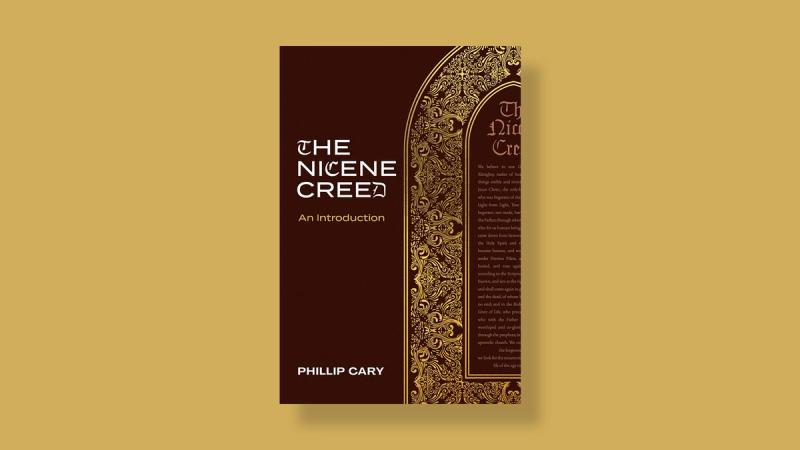LEXHAM PRESS | 2023 | 248 PAGES (HARDCOVER) | $19.99
The upcoming seventeen-hundredth anniversary of the Council of Nicaea in 2025 gives us an incentive to learn more about that pivotal time in history and the creed that came of it. To this end, one can scarcely find a more accessible source than Phillip Cary’s new book, The Nicene Creed: An Introduction.
It’s a remarkable book in many ways. Before even opening its pages, I was impressed by its beauty. The publisher has not skimped on aesthetics, and a gilded pattern on both front and back covers moves on to fill the inside cover. The book is relatively small (five by eight inches), easy to handle, with comfortable print, inviting even the most timid of readers. The greatest feature of the book, however, is clearly the text. With his previous books and lectures, Cary has justly earned a reputation for clarity. Gathering from his experience in teaching university students, he has learned to address both spoken and unspoken questions, covering challenging theological concepts with simplicity and ease. Some of these questions include “Who created God?” and “Did God create the devil?” (32–33).
In fact, Cary assumes that most of his readers will be ordinary Christians who are “familiar with the Bible but not necessarily with the traditions of Christian theology” (11). This is an audience he brilliantly addressed in his first popular book, Good News for Anxious Christians: 10 Practical Things You Don’t Have to Do.
But his aim, Cary clarifies, is not to simply increase his readers’ knowledge and vocabulary. It is, as he says, “Getting our ears more fully tuned to hear these words gets us more deeply immersed in the richness of Christian worship” (11). He admits, however, that he will be “very happy if this book serves some readers as a gateway to theological studies” (12).
The book starts with a bang as he writes, “The Nicene Creed originated because ancient Christians were appalled” (1). Some authors have used nuanced approaches to the history of the creed, explaining Arius’s motives and letting the readers draw their own conclusions. But this is not Cary’s aim. He is convinced that the faith articulated at the Council of Nicaea is essential to Christianity.
That opening sentence thrusts the reader into the animated controversies of the fourth century. “They had a good reason to be appalled,” Cary explains. “To say ‘there was once when [Jesus] was not’ . . . would mean that he is not really God at all, but one of the things God made. To say this would be to say that what Christians have been doing all along, worshiping Jesus as Lord, is the sort of thing pagans do: worshiping something that is not fully, truly, ultimately God” (1–2). After communicating this urgency, Cary takes the reader through a brief history of the creed and then through a careful, line-by-line reading, including semantical explanations in order to give access to the words’ layers of meaning.
Given that there are several translations of the creed in circulation, Cary provides his own, being careful in the attempt “to stay as close as possible to the original Greek” and explaining any contrasting word choices. As a translator and lover of languages, I was particularly intrigued by these explanations. For example, I was surprised to learn that the Greek version of the creed gives credit to Mary’s participation by stating that Jesus “was incarnate from the Holy Spirit and [kai] the Virgin Mary” (or, more precisely, “Mary the Virgin”). Most English translations, I find, follow the Latin, which distinguishes the two interventions by using different prepositions (“by the Holy Spirit of the Virgin Mary”). Curiously, the Italian, Spanish, and French translations go further in their distinction, separating the sentence into two and adding words. (I was also surprised to see that the Italian version translates “died” instead of “suffered,” a choice that seems to miss the full richness Cary uncovers in his exposition.)
The book includes a five-page excursus, which Cary defines as “a quick dive into Trinitarian terminology outside of the Creed for those who wish to study further” (93), along with a simpler presentation of the Trinity in the epilogue. The book then concludes with notes and subject and Scripture indexes.
But this is not primarily a history account or a word-by-word commentary. At the start, Cary states a theme he is faithful to keep to the end: “This book is not about a heresy but about the truth: the gospel of Jesus Christ taught by the Creed that grew out of the faith of Nicaea” (3).
Cary repeatedly reminds his readers that “the Nicene Creed is a summary of the gospel of Jesus Christ.” It is so because “it is not telling us what to do but telling us what God has done for us and our salvation—all the things we cannot do to save ourselves, transform our lives, and make ourselves good Christians, for they are things that only God can do” (12).
As such, “the Nicene Creed is a blessing and a joy,” a joy Cary communicates with enthusiasm and that becomes a primary motivation for his writing: “It brings me great joy, and I wanted to make that joy accessible to those who may be unfamiliar with it.” Cary’s passion in exploring this gospel is evident. Mirroring the careful and wise economy of words of the creed, he manages to highlight important features such as a theology of the cross and a balance between the “already” and the “not yet” with admirable fairness, leaving the reader satisfied and yet hungry for more.
Cary’s The Nicene Creed can be read in a day or savored for months—and both approaches have their benefits. The large number of quoted or referenced Scriptures makes this an excellent tool for a Bible study for both new and seasoned Christians. In any case, readers can expect to gain a fresh and richer appreciation of the creed they most likely recite in church and of the gospel the creed expresses.









